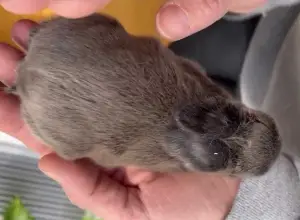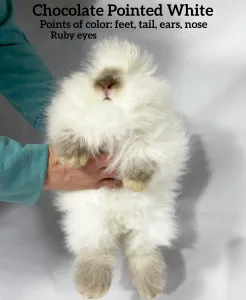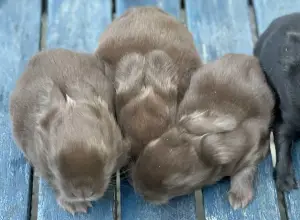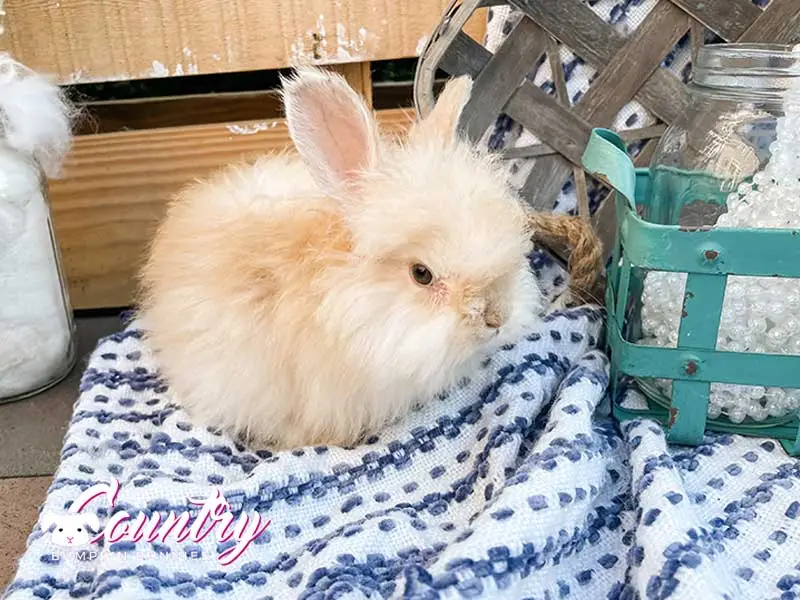English Angora Basic Genetics
- Home
- English Angora Basic Genetics
Basic Rabbit Color Genetics & Terminology For Beginners
Here is some basic terminology to begin learning rabbit coat color genetics for the English Angora rabbit breed. The color of wool or fiber of an English Angora is determined by many different genes that control the outcome of your rabbits coat color. Each rabbit is a base color with a density of dark to dilute pigment. Then you may have a pattern on your coat which makes it solid or not solid. The shaft of the fiber can change colors which is determined by the extension gene and that can get complicated with all the different types of pigment and ticking.
The genes that make up the determining factor of a rabbits coat color are all combined into something called a Genotype. The definition of a Genotype is the genetic makeup of an organism or group of organisms with reference to a single trait, set of traits, or an entire complex of traits. It is also the sum total of genes transmitted from parent to offspring.
Example of what a Genotype looks like: AaBbCcDdEe
When you see a written Genotype, you may be confused as to what each letter stands for. Science has not confirmed each part of color genetics yet but what we do know and understand so far are the following Alleles (also called allelomorph). Alleles are defined as one of two or more versions of a genetic sequence at a particular region on a chromosome. An individual inherits two alleles for each gene, one from each parent. These two Alleles are found at the same place on a Chromosome. Alleles are the individual letters found in the Genotype and they are a specific copy of a gene.
As mentioned above, chromosomes is where the alleles are located. Chromosomes are defined as a structure found inside the nucleus of a cell. Chromosomes are made up of proteins of DNA organized into genes. Each cell normally contains 23 pairs of chromosomes. A particular gene’s two alleles are located in a the same region in two homologous chromosomes which as stated, are inherited from each parent.
Another term you may run into while learning the genetic make up of a genotype is a Locus or Loci. It can be confusing knowing the difference between an allele and a locus. An allele is an alternate form of a gene and a locus is the location of that gene on a chromosome. So a locus is a more specific location of an allele. Loci is just the plural form of Locus.
Alleles will be dominant or recessive. A dominant allele means that the physical action is expressed. You will see this in the Phenotype of the rabbit. A recessive allele is a hidden gene. It is not expressed and you will have to do some work to figure out what the rabbits recessive traits are. I have now mentioned phenotype. The term phenotype is used to describe a visible trait or characteristic.
Depending on each allele’s DNA sequence, the genotype can be described as a homozygous or heterozygous of a particular gene. We mentioned homozygous above once. This means that the organism’s genome has two identical alleles for a specific gene. Both alleles contribute equally to the appearance of the trait. However, heterozygous genotype is different. It contains two different forms of the genes. Remember “homo” = same and “hetero” = different.
Let’s go back to junior high school days. Remember punnet squares? The Punnett square is a square diagram that is used to predict the genotypes of a particular cross or breeding experiment. Apply this to rabbit coat colors below. One parent is Aa and the other parent is AA. So the four possible offspring are AA, Aa, AA, Aa. This can be fun to play around with if you love genetics. We will get into what the A and a stand for coming up.

Now you have some basic terminology to begin understanding how the letters fall into place in a genotype. Next, let’s discuss each Allele of the genotype. For rabbits there are not a lot of alleles that we understand just yet. The ones that are obvious are the ones that have been figured out. It can get much more complex as you start trying to figure out mutations of genes. For now, we will concentrate on the following:
A controls the coat color pattern
A = Agouti (most dominant)
at = Otter (aka tan gene, recessive to “A” and dominant to “a”)
a = Self (most recessive)
B controls coat color base
B = Black (complete dominance)
b = Chocolate (recessive and takes homozygous bb to show)
C = Full color
cchd = (chinchilla dark)
cchl = (chinchilla light and sable)
ch = (stands for Himalayan or Pointed White “PW” in this breed)
c = (stands for albino or Ruby Eyed White “REW” in this breed)
D controls the density of the coat color
D = Dense
d = Dilute
E Controls the extension of dark pigment
E = Normal extension
e = No extension
ej = Harlequin or Japanese brindling
es = Partial extension, Steel
en = Spotting gene, Broken pattern known in this breed
V Controls Blue eyes and white markings from this gene
V = Non Vienna dominant gene (no blue eye gene, normal eyes)
v = Vienna recessive (carrier or marked blue eye gene)
W Controls the banding width on the hair shaft
W = Wideband (normal color and dominant)
w = Non Wideband (doubles color bands and is recessive)
Other influences on genes are modifiers (many modifiers we do not know or understand in rabbit genetics YET)
+ = Rufus factor or modifier influences as a polygene (stand alone gene that does not rely on any particular gene). Rufus is latin for red. Rufus is the intensity of the red color in an angora coat. This plus symbol also symbolizes Umbros modifier. The Umbros factor darkens the blue-gray bands in agouti colored coats. These two modifiers can make two agouti bunnies born the same color look like two completely different colors when fully mature.
VM = Vienna Marked recessive but shows in the phenotype
VC = Vienna Carrier recessive blue eye
Please note that a vienna carrier is only known for sure if one parent is a BEW since they must pass one vienna gene onto their offpring. The only way to know for sure if a rabbit carries vienna is if it produces a BEW or VM in a litter. You can test breed a possible VC with a BEW and see if they produce a BEW. If you choose to breed a possible carrier to a VM, it may take several offspring to rule out vienna. You can have two litters of 5 with no sign of vienna and then the third litter produce a VM. It is easiest to test breed to a BEW and try for at lease a dozen offspring before getting your answer. Please see our section on the Vienna Gene for more detailed info on the blue eye gene.
EA Agouti Examples "A"

Chestnut Agouti newborn EA kit. Notice entire underside is light which is agouti markings.

Three week old chestnut kits. Broken patterned chestnut agouti on the left.

This is a Chestnut Agouti junior EA. Chestnut is the regular black based agouti color.

High Rufus Chocolate Agouti senior with a few months wool growth.
EA Otter Examples "at"

Comparing a lilac otter to a self lilac. Otter has the light underside.

Black young junior otter EA

Older lilac otter junior EA

Black otter English Angora
EA Self Examples "a"

These very young kits are solid in color including the belly. They are self chocolate EA kits about a week old.

This is a 3-4 week old blue self kit.

This EA is a young junior dilute tort. Tort is a self color even though it is two-toned.

This is a chocolate self-senior EA in coat.
EA Black Examples "B"

This is a very young self black kit. Notice is it solid and dark all over. The wool has not grown out enough to stretch the color and lighten.

Junior black self bunny that has some growth to his coat. As the wool grows it stretches the pigment. Notice the face does not change in color though.

This is a black based japanese harlequin. The base color is black, however it has a patterned coat type.

This is actually another self black junior but the white you see on him is from the vienna gene. He is a vienna marked black self.
EA Chocolate Samples "b"

This is a chocolate based kit in the harlequin pattern.

Here we have a self chocolate junior. The muzzle remains a deep dark brown and as the wool grows, the pigment stretches out and becomes lighter.

This color is called Chocolate Ermine. Its base color is chocolate as you can see coming in on the ears and nose. The body remains white with very little chocolate ticking/shading over the body.

This EA is a chocolate based agouti. His color is called Chocolate Agouti. Born dark chocolate with agouti markings, his coat will change to this in just a matter of weeks.
EA full color samples "C"

This is a Tortoishelle and you can see that it has full color showing.

his bunny is a self black based broken pattern. Even though it has the broken pattern, it does have full color where black is present.

This EA junior is a black otter. It has full color with the otter (tan) gene.

his EA is red and full color.
EA Chinchilla Dark Examples "cchd"

Black based EA baby chinchilla showing chinchilla dark pattern.

his EA is a black magpie. Magpie requires cchd/chinchilla dark gene to get this harlequin pattern without any rufus.

This lilac pearl EA is a good representation of the cchd gene.

Senior EA with her wool grown out to show the chocolate chinchilla pattern.
EA Chinchilla Light Examples "cchl"

This is a sable EA kit. You can see the sepia color on the back.

This is a litter born from a sable magpie. You can see black based magpie, chocolate based magpie, and a sable pearl kit.

Here is a lilac sable pearl EA. Notice the sepia coloring on this compared to the lilac pearl photo above in the “cchd” examples.

Here is the same sable bunny as in the sable kit pictured. You can see how the color changes quite a bit as the wool grows out. The eyes have a red tint to them.
EA Pointed White Examples "ch"

The above litter are all dilute pointed white EA. The points are just starting to show. They are born pink/naked and at close to two weeks of age, the point begin to show. The best place to look is the top of the tail for color to show up.

This is a junior lilac pointed white VM (vienna marked) EA. There are many colors of pointed and they are all gorgeous with pink/lavender eyes but it is called “ruby eyes” in rabbits. Points are heat sensitive, in warmer temps they disappear and look like a REW.

This picture shows where the points are on the rabbit.

Don’t forget the tail! Pointed White has a shaded tail just like on the feet, ears, and nose.
EA Ruby Eyed White Examples "c"

Ruby Eyed White kit, also known as REW. White solid body and pink eyes. This is considered albino.

his is a young junior REW EA.

Here is a REW that has been clipped down for the summer. Beautiful pink eyes and flawless white wool.

Here is our “Pinkalicious” EA doe when she was a young senior. Solid white with ruby eyes (pink pupils and lavender iris’).
EA Dense Coat Examples "D"

This example of a dense coat is a black heavy vienna marked EA bunny.

his is a black fox EA. Black makes this a dense colored coat.

This bunny is a chocolate based otter EA. Chocolate is the dense color on this EA coat.

This is a senior black VM (vienna marked) EA. She. has been shaved down but you can still see the dense black color on her face.
EA Dilute Coat Examples "d"

This cute little bunny is a broken booted blue. Blue is the dilute for black.

This is another blue junior EA. Blue is more slate gray in color. It has a deeper shade than the other dilute color, lilac.

Here we are showing an example of a lilac otter. Lilac is the dilute of chocolate and looks more dove gray in color.

This beauty is a blue chinchilla. So this is blacks dilute again and the proper name for this color is called Squirrel.
EA Steel Examples "Es"

This is a gold tipped steel black EA. Photo credit to Candy’s Rabbitry.

This is a silver tipped steel blue EA. Photo credit to Wonderland Rabbitry.

This was a Gold Tipped Steel Chocolate buck of ours.

This was one of our silver tipped steel lilac EA juniors we produced. Her dadis the bunny in the GTS photo.
EA Full Extension Examples "E"

These are self chocolate kits that are showing full color and full extension of color.

These are both chestnut agouti. One on the left is a broken pattern and both are good examples of full extension color.

This bunny is a self lilac and is a full extension as well.

This is a litter of chinchilla juniors. Chinchillas are full extension color.
EA Harlequin Examples "ej"

This young EA is a dilute magpie harlequin. It takes both the chin gene and the harlequin gene to make a magpie.

This is another magpie harlequin English Angora junior rabbit. This bunny has the chinchilla gene to allow white rather than red/orange rufus coloring.

This bunny is a japanese harlequin EA. The difference in japanese and magpie are the rufus verses chinchilla that covers up the rufus.

This split face japanese harlequin EA is our main herd buck for our japanese harlequin program. They have amazing wool!
EA Harlequin Examples "e

Tort is a non extension color. here you see a young EA tort kit.

Fawn is a beautiful example the of non extension “e” gene.

This is a chocolate fox. Fox is known as torted otter. You must have the at tan gene to be otter but in combination with non extension “e”, you get Fox.

This is an ermine which is non extension chinchilla. Ermines can be used to make a magpie harlequin pattern.
EA Examples of Broken "en", Vienna "v", & Wideband "w"

En is the Broken pattern as seen here in this photo of a broken self black EA junior.

This is a BEW, Blue Eyed White, it has two copies of the vienna gene “vv”.

This is a heavy Vienna marked bunny. It should be solid in color but has white from the vienna gene as well as blue eyes. This color is called Black VM (vienna marked). The genes are Vv on a vienna marked bunny.

On the left: wideband and the other is normal banding. “W” is normal banding and dominant. “w” is the recessive wideband gene that will show the wider shaded bands. The wideband on the left is also high rufus (both are chocolate agouti).

